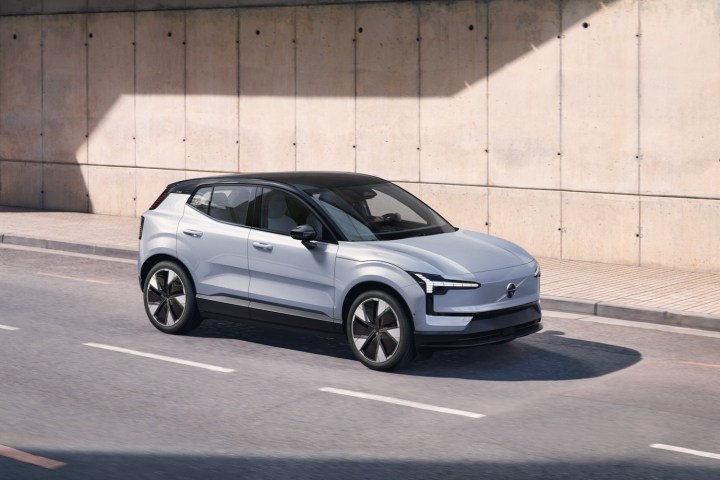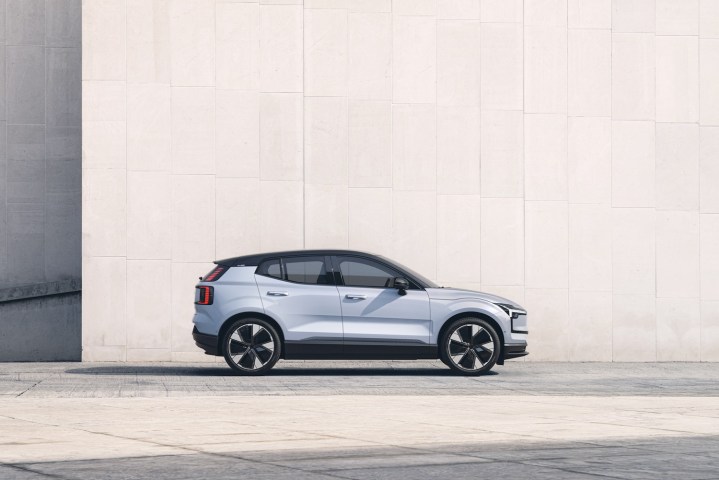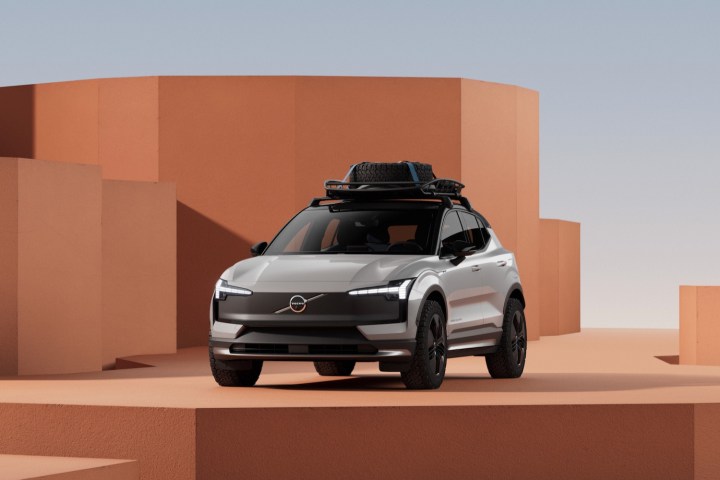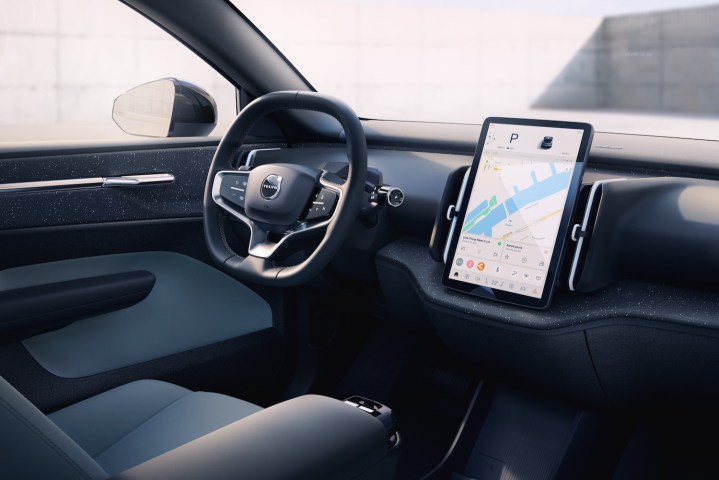
The budget EV market is seriously heating up. While it turns out that the Chevrolet Bolt EV isn’t long for this world, there’s a new low-cost electric car in town, and it’s set to make more affordable electric cars a whole lot more stylish. The Volvo EX30 “small SUV” has yet to be released to the public, but already many EV shoppers are considering it for their next car, considering its low price, solid range, and stylish design.
Curious about the Volvo EX30? We’ve been keeping an eye on the EX30’s announcements and release, and can’t wait for it either. Here’s everything we know about the Volvo EX30 so far.
Volvo EX30 price

The Volvo EX30 is an attractive car, but one thing that makes it even more attractive is its low price. So how much does it cost? Volvo announced that it’ll start at $34,950, which makes it one of the most affordable electric cars on the market right now.
Of course, many drivers will want to upgrade to models other than the base model, and doing so will of course add cost. So, unless you’re really looking to spend the least possible on an electric car, expect to pay a little more than that base price, especially if you want a longer range, faster performance, or all-wheel drive. We don’t yet know how much those upgrades will cost, but for some context, the cost of a Kia EV6 jumps up by $10,000 when you move from the RWD base model to the AWD model.
Will the Volvo EX30 be eligible for a $7,500 federal tax credit? Unfortunately, the EX30 will not qualify, because it will be built in China. The Inflation Reduction Act stipulates a number of requirements for eligibility, including final assembly in North America.
Volvo EX30 release date
The Volvo EX30 may have been announced, but it’s not available for purchase just yet. U.S. buyers can, however, reserve a place in line with a $500 refundable deposit if they want. Deliveries will begin in the summer of 2024, and buyers will be able to configure their cars in the fall of 2023.
Volvo is releasing a Cross Country model of the EX30 too, however, that model won’t be available until the end of 2024.
Volvo EX30 colors and models

Like most modern cars, the EX30 will be available in a series of different models and colors. In other words, you’ll be able to customize the car to your needs when you buy — however, doing so may increase the cost a little.
The base model of the EX30 is a single-motor variant with a so-called “standard range” battery, but this model will only be available in select markets. One step up from there will give you the Single Motor Extended Range model, which, as the name suggests, keeps the single motor but gives the car a bigger battery for a longer range. Then there’s the Twin Motor Performance model, which keeps the longer-range battery, but uses that battery up a little quicker with a second motor for better performance.
The Volvo EX30 may be affordable, but it doesn’t skimp on performance.
There’s a fourth model too, though it won’t be available at launch. The EX30 Cross Country adds front, rear, and side skid plates, along with exclusive Cross Country badging and 19-inch wheels. Volvo hasn’t said what powertrain you’ll get with the EX30 Cross Country, but in all likelihood, it’ll be the dual-motor all-wheel drive variant.
The EX30 will be available in a number of different colors too. On the outside, there are five color variants, including Vapour Grey, Onyx Black, Moss Yellow, Crystal White, and Cloud Blue. On the inside, there are a few options too — Breeze, Mist, Pine, and Indigo. All of the exterior and interior color options are relatively tame, with the Moss Yellow definitely being the most distinct.
Volvo EX30 charging speed and range
| Model | Charging speed | Time from 10-80% | Range |
| Single-motor standard range | 134kW | 26 minutes | 200 miles |
| Single-motor extended range | 153kW | 26.5 minutes | 275 miles |
| Dual-motor extended range | 153kW | 26.5 minutes | 265 miles |
The base model of the car, which is the standard range model with a single motor, offers a lithium iron phosphate (LFP) battery that costs less and lasts longer than standard nickel-manganese-cobalt (NMC) batteries but weighs more. This model will deliver a range of up to 200 miles, and is really built for day-to-day city use, and not for those who plan on taking the car on road trips. This variant can charge at 134kW, meaning it’ll take 26 minutes at this speed for the car to charge from 10% to 80%.
The other models offer lighter NMC batteries to help extend range. The result is that on the single-motor variant, you’ll get up to 275 miles of range, while on the dual-motor model, you’ll get 265 miles. Both of these models will be able to charge at up to 153 kW, and in ideal conditions will charge from 10% to 80% in 26.5 minutes.
Both of the battery packs can charge reasonably fast, though it’s unfortunate that Volvo isn’t yet offering cars that can charge at the ultra-fast 350kW speeds that you’ll get on cars like the Kia EV6 and Hyundai Ioniq 5.
Volvo EX30 performance

The Volvo EX30 may be affordable, but it doesn’t skimp on performance. In fact, if you get the right model of the EX30, you’ll be getting the fastest production car that Volvo has ever made.
The single-motor model isn’t the fastest model, but despite the low price tag, it’s still a relatively quick car. The car achieves 284 horsepower and 253 lb-ft of torque and can reach 60 miles per hour in 5.1 seconds. Sure, it won’t compete with some of the faster and more expensive electric cars out there, but it should provide enough oomph for most drivers.
For drivers who want a little more pep, Volvo offers a dual-motor model with 422 horsepower and 400 lb-ft of torque. That will hustle you from 0 to 60 mph in 3.4 seconds, which makes it Volvo’s fastest production car ever. Among its electric peers, it will outrun Ford’s Mach-E GT Performance Edition (3.5s), but can’t quite hang with Tesla’s Model Y Dual Motor AWD (3.1s).
Volvo EX30 tech features

The Volvo EX30 isn’t just affordable and fast, it’s also packed with great features. As you would expect from a modern Volvo car, the EX30 will come with Volvo’s infotainment system based on Android Automotive, meaning it’ll make use of Google Maps and other Google services. The car will also feature support for Apple CarPlay, so Apple fans won’t be stuck without options — and in fact, the EX30 will be the first Volvo car with wireless CarPlay connectivity. That’s all accessible through the 12.3-inch center screen.
The car comes with constant connectivity, with 5G connectivity where available. And, it’ll offer Volvo’s Park Pilot Assist feature, which allows the car to identify parking spots and park itself as the driver watches. With the feature, it can handle parallel, curved, perpendicular, and diagonal parking, making parking in smaller spaces a whole lot easier.
Our Volvo EX30 wishlist
The Volvo EX30 comes with everything we would expect from a solid modern EV, and more considering its price range. At this point, our only main hope is that the upgraded models won’t charge too much of a premium over the base model, especially when it comes to the longer-range option — allowing customers to get a little more range from their car without having to pay more than necessary.



